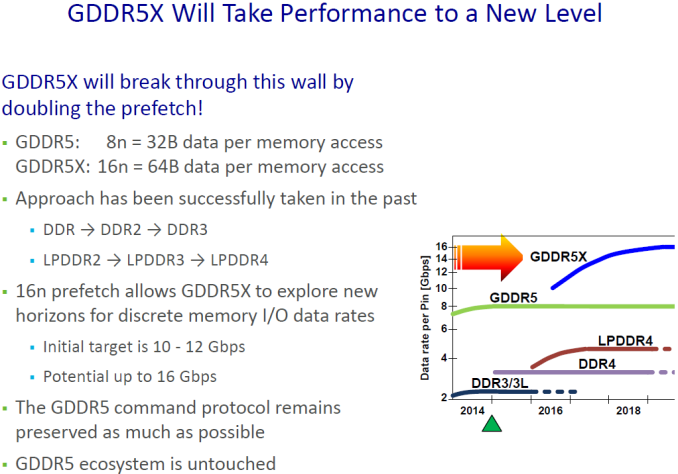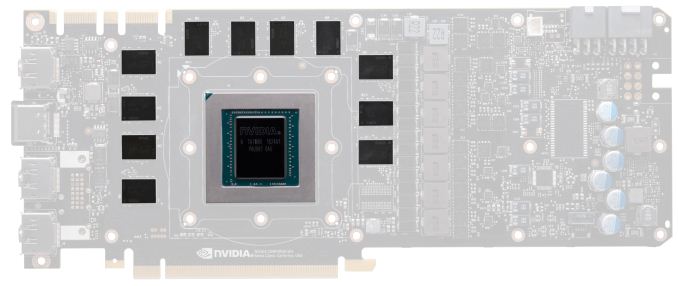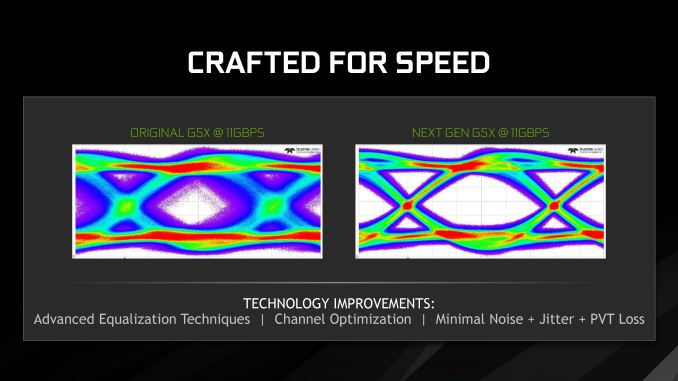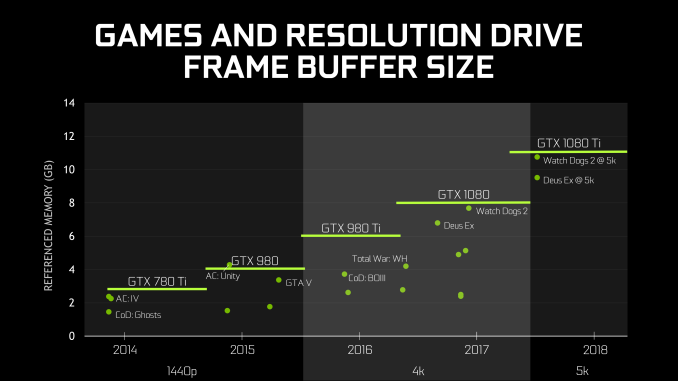The NVIDIA GeForce GTX 1080 Ti Founder's Edition Review: Bigger Pascal for Better Performance
by Ryan Smith on March 9, 2017 9:00 AM ESTSecond Generation GDDR5X: More Memory Bandwidth
One of the more unusual aspects of the Pascal architecture is the number of different memory technologies NVIDIA can support. At the datacenter level, NVIDIA has a full HBM 2 memory controller, which they use for the GP100 GPU. Meanwhile for consumer and workstation cards, NVIDIA equips GP102/104 with a more traditional memory controller that supports both GDDR5 and its more exotic cousin: GDDR5X.
A half-generation upgrade of sorts, GDDR5X was developed by Micron to further improve memory bandwidth over GDDR5. GDDR5X further increases the amount of memory bandwidth available from GDDR5 through a combination of a faster memory bus coupled with wider memory operations to read and write more data from DRAM per clock. And though it’s not without its own costs such as designing new memory controllers and boards that can accommodate the tighter requirements of the GDDR5X memory bus, GDDR5X offers a step in performance between the relatively cheap and slow GDDR5, and relatively fast and expensive HBM2.
With rival AMD opting to focus on HBM2 and GDDR5 for Vega and Polaris respectively, NVIDIA has ended up being the only PC GPU vendor to adopt GDDR5X. The payoff for NVIDIA, besides the immediate benefits of GDDR5X, is that they can ship with memory configurations that AMD cannot. Meanwhile for Micron, NVIDIA is a very reliable and consistent customer for their GDDR5X chips.
When Micron initially announced GDDR5X, they laid out a plan to start at 10Gbps and ramp to 12Gbps (and beyond). Now just under a year after the launch of the GTX 1080 and the first generation of GDDR5X memory, Micron is back with their second generation of memory, which of course is being used to feed the GTX 1080 Ti. And NVIDIA, for their part, is very eager to talk about what this means for them.
With Micron’s second generation GDDR5X, NVIDIA is now able to equip their cards with 11Gbps memory. This is a 10% year-over-year improvement, and a not-insignificant change given that memory speeds increase at a fraction of GPU throughput. Coupled with GP102’s wider memory bus – which sees 11 of 12 lanes enabled for the GTX 1080 Ti – and NVIDIA is able to offer just over 480GB/sec of memory bandwidth with this card, a 50% improvement over the GTX 1080.
For NVIDIA, this is something they’ve been eagerly awaiting. Pascal’s memory controller was designed for higher GDDR5X memory speeds from the start, but the memory itself needed to catch up. As one NVIDIA engineer put it to me “We [NVIDIA] have it easy, we only have to design the memory controller. It’s Micron that has it hard, they have to actually make memory that can run at those speeds!”
Micron for their part has continued to work on GDDR5X after its launch, and even with what I’ve been hearing was a more challenging than anticipated launch last year, both Micron and NVIDIA seem to be very happy with what Micron has been able to accomplish with their second generation GDDR5X memory.
As demonstrated in eye diagrams provided by NVIDIA, Micron’s second generation memory coupled with NVIDIA’s memory controller is producing a very clean eye at 11Gbps, whereas the first generation memory (which was admittedly never speced for 11Gbps) would produce a very noisy eye. Consequently NVIDIA and their partners can finally push past 10Gbps for the GTX 1080 Ti and the forthcoming factory overclocked GTX 1080 and GTX 1060 cards.
Under the hood, the big developments here were largely on Micron’s side. The company continued to optimize their metal layers for GDDR5X, and combined with improved test coverage were able to make a lot of progress over the first generation of memory. This in turn is coupled with improvements in equalization and noise reduction, resulting in the clean eye we see above.
Longer-term here, GDDR6 is on the horizon. But before then, Micron is still working on further improvements to GDDR5X. Micron’s original goal was to hit 12Gbps with this memory technology, and while they’re not there quite yet, I wouldn’t be too surprised to be having this conversation once again for 12Gbps memory within the next year.
Finally, speaking of memory, it’s worth noting that NVIDIA also dedicated a portion of their GTX 1080 Ti presentation to discussing memory capacity. To be honest, I get the impression that NVIDIA feels like they need to rationalize equipping the GTX 1080 Ti with 11GB of memory, beyond the obvious conclusions that it is cheaper than equipping the card with 12GB and it better differentiates the GTX 1080 Ti from the Titan X Pascal.
In any case, NVIDIA believes that based on historical trends, 11GB will be sufficient for 5K gaming in 2018 and possibly beyond. Traditionally NVIDIA has not been especially generous on memory – cards like the 3GB GTX 780 Ti and 2GB GTX 770 felt the pinch a bit early – so going with a less-than-full memory bus doesn’t improve things there. On the other hand with the prevalence of multiplatform games these days, one of the biggest drivers in memory consumption was that the consoles had 8GB of RAM each; and with 11GB, the GTX 1080 Ti is well ahead of the consoles in this regard.














161 Comments
View All Comments
mapesdhs - Saturday, March 11, 2017 - link
Some 780 Ti owners may have oc'd their cards that high, but not many I suspect. I've been searching for 780 Ti cards for a while, for CUDA, most tend to be around 980MHz at best.mapesdhs - Saturday, March 11, 2017 - link
Also recall one model which was 1002MHz.Chaser - Thursday, March 9, 2017 - link
Glad to see I have no need for a card that powerful and expensive. I run a single 27" 2K IPS monitor and my Gigabyte Extreme gaming 1080 is more than enough to keep me on the high end for years to come. 4K is 90% bragging rights in terms of visible difference and also game developer support.sharath.naik - Thursday, March 9, 2017 - link
I think you may need to consider multi monitor gaming. Then this card makes sense if you want to use this in a small case that allows only one GPU.mapesdhs - Saturday, March 11, 2017 - link
Depends on the game and what kind of detail one likes. Site reviews and forum commentaries also don't take into account game mods which often significantly increase the GPU load (check out the OCN Best Skyrim Pics thread, have a look at the builds people are using).I like to play games with all details/settings at maxed out. Thus, such a card is very relevant. Sure, plenty of players don't mind if the fps drops to 30 or 40, but some like it smooth at a minimum. I've currently no interest in high frequency monitors (which ironically can sensitise one's vision anyway), but I do seek 60Hz minimum sync'd, something I can't get atm with a single 980 at 1920x1200. I plan on moving up to 4K soon; with a 1080 Ti, and likely being able to get away with turning of some of the AA options because of the higher pixel density (which regains performance), minimum 60Hz looks very possible.
It depends on one's needs; everyone has different thresholds of what they're happy with.
Chaser - Thursday, March 9, 2017 - link
Very well written, balanced review. Nicely done Ryan.BrokenCrayons - Thursday, March 9, 2017 - link
+1!nismotigerwvu - Thursday, March 9, 2017 - link
Quality work as always Ryan! I spotted a minor typo on the conclusions page "Because the GeForce GTX 1080 Tii Founder’s Edition isn’t NVIDIA’s first GP102-based product". Did a little midnight coffee spill and make that i key sticky? :)BrokenCrayons - Thursday, March 9, 2017 - link
Typo/Error also on Page 4 of the review in the line that reads:"For our review of the GTX 1060, we’re using NVIDIA’s 378.78 driver."
Probably should be "GTX 1080 Ti"
The table directly below that line is also missing the GTX 1080 Ti in the video cards section.
Ryan Smith - Thursday, March 9, 2017 - link
Thanks!